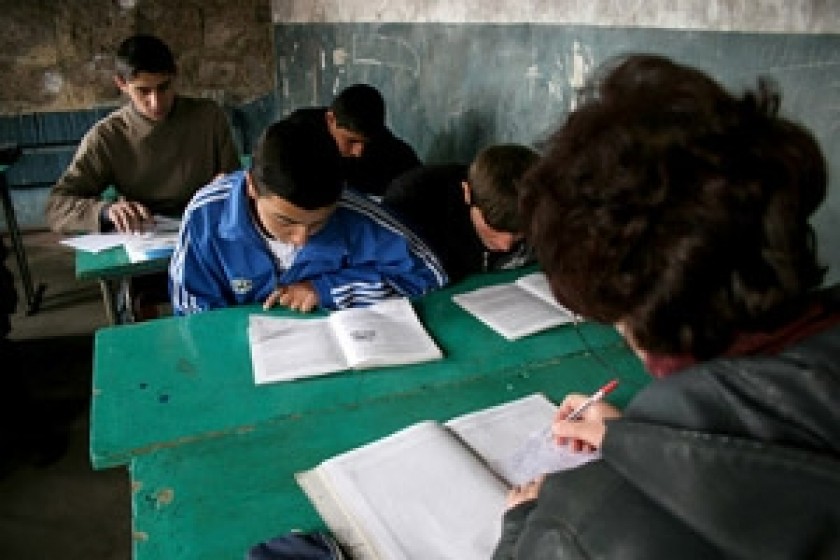
In Between Old and New Schools
A corridor with an earthen floor and walls in need of whitewash leads to the teacher's common room. The bare stone transmits the cold.
"Roj bash (good morning)", I say to second-grade students Zeytun and Avdal. We had breakfast at their parents' house; their father, Vazir Avdalyan, is a mathematics teacher in this school.
This morning I was playing with Zeytun and Avdal's younger brother, two-year-old Tital. He does not know a single word of Armenian. Before going to school Zeytun and Avdal didn't either. Now they speak it fluently.
In the teachers' room at the Stepanos Shahumyan School in Alagyaz, the teachers are gathered around an electric stove waiting for the bell to ring to go to their classes.
The coffee pot has been on the stove since early morning.
"Would you like coffee?" they asked us even before saying good morning.
Some teachers are Yezidis, some are Armenians. Several teachers come from the neighboring villages.
"Isn't it hard to get here every day?" I ask.
"Of course it is," the chemistry teacher replies. "It is very difficult, since there is always a problem with transportation, especially in winter."
This loud-voiced, enthusiastic woman is from Alagyaz. Whatever I ask and whomever I ask, she is always the first to reply.
"As soon as we get the new school," she says, "we would like to give some classrooms in this school to the teachers who come from far away to have a place to stay here."
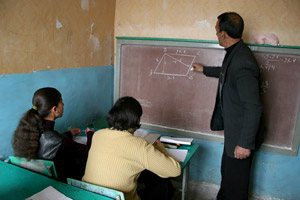 |
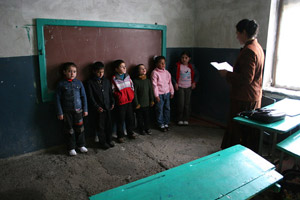 |
The newly built white edifice is visible from the window. The Governors Office has promised to put the new school into commission this September.
Principal Rustam Aloyan starts telling me about the school. But it is so noisy in the room that I can hardly hear anything. Aloyan tells the teacher to go to their classrooms and not disturb our conversation.
"No, Comrade Aloyan (everyone calls each other comrade in this village), the bell hasn't rung yet. Besides, we want to talk and listen, too," exclaims the chemistry teacher. The other female teachers unite with her and Aloyan gives up; what can he do against so many women?
Aloyan tells me that this building used to be a kindergarten. Alagyaz had a well-equipped, two-story school that was destroyed in the 1988 earthquake. After that the school moved into tents and then into the wooden domiks of 10-12 rooms.
After the earthquake many families left the village, mainly moving to Moscow. According to the principal some 20 families left immediately after the earthquake. It was at that time that the kindergarten in Alagyaz shut down, and five or six years later the building was given to the school.
In 2004 the Armenian government began building a new school. The foundations had been laid by Kazakhs two or three years after the earthquake.
"They promised to give us the new school last year, but have delayed," Aloyan says. "The building process is complete but the school is still empty. They keep promising us furniture, but we don't have anything yet. Let's see if we get it in September.
But that's not the only problem. I sent the main demands regarding the school to the Governor's Office in writing but haven't received an answer yet."
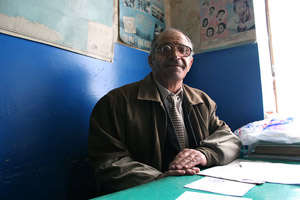 |
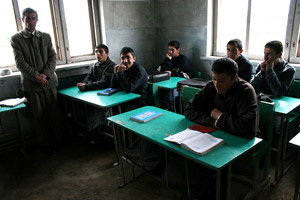 |
The wire-mesh fence is one of the items on the list. It is pretty ugly, and some of the mesh is already bent, not to mention the peeling paint revealing the rust on the gatepost.
The building's gutters are short, plywood sheets so thin that already warped in the strong winds.
The roof is of such poor quality that it has already been repaired this year after being almost ruined by the rains.
The inside walls were painted in winter, but "the paint had no time to dry, so it will peel off in a year."
The electric wiring and plumbing are not finished yet.
"The gymnasium and assembly hall of the ruined school survived. We would like to join them to the new school. Children in Alagyaz haven't done sports for twenty years because we haven't had the facilities. I applied to the governor's office with this request as well but haven't received a response yet.
"Aragatsotn Marz consists of four regions-Talin, Aparan, Aragats, and Ashtarak. They put these regions together and made a marz. To participate in any meeting, to bring up any problem, you have to drive 70 km to get to the governor's office. It's especially hard bearing in mind the state of the roads and the lack of transportation."
The ruins of the old school have never been cleared. The area around the new school is not asphalted.
"Look, there is no proper entrance here," the principal says. "We applied to the provincial government and Ashot Daveyan, the head of the Building Department said, "Hey, you want the same school as in Vardablur?" Vardablur is a neighboring Armenian village. The provincial government has never discriminated between Yezidi and Armenian villages so I cannot understand Daveyan's attitude."
"Vardablur has never produced an excellent student," Aloyan carries on indignantly, "and we produce medallists every year. Our students are admitted to universities every year. This year we have twelve children studying in university in Yerevan and Vanadzor."
We are back to the school and take a walk into the classrooms.
The classrooms are as cold as the corridor. The kerosene heaters are on from November 10 to April 20. The school gets three liters of kerosene per day, like every school in the Republic.
"They are often late with the kerosene," Aloyan complains. "They also don't take into consideration that this region is Armenian Siberia and we need more kerosene than average schools."
The windows are covered with plastic; many of them do not have glass. The classrooms are mainly small; the classroom adjoining the teachers' room can only fit three desks. There is an empty classroom that has a ping-pong table without a net. Apparently it serves as a gym.
First- and second-year students get textbooks free. In the upper grades they pay 400 drams per book for a year. At the end of the year they have to give the books back.
There are 73 students at the school. They are Yezidi children as well as a few from Armenian families living in Alagyaz. For many parents it is difficult to cope with school expenses. Aloyan says that the provincial government provides no allowances for the children. For some children, especially the orphans, the school covers the costs itself.
 |
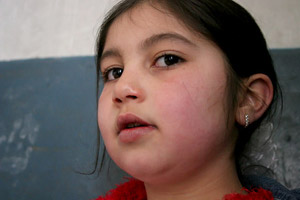 |
"They come to me and say I don't have a notebook. And I give it to them free; what to do if they cannot pay for it?"
The first class is preparing for the Alphabet performance. Like Avdal and Zeytun, these kids did not speak Armenian before going to school.
Every subject in the school is in Armenian. Some ten years ago, the Kurdish language was allowed from second to eighth grade, with at least half of the pupils being Yezidis (the villagers here oppose the official labeling of them as Yezidis by nationality, explaining that they are Kurdish by nationality and Yezidi by religion).
"Now Kurmanji (Kurdish language) is out of the program. We teach children Kurmanji out of the program, so as not to let them forget their mother tongue."
"What about the teachers' salary?" I ask. "Is it OK?"
"45,000 to 90 000 drams per month," Aloyan replies.
"Not bad, especially for a village."
"Well, being a mountainous region we have a 20% higher salary than teachers in the cities. It's pretty good."
"Pretty good? For what, Comrade Aloyan?" Again the chemistry teacher speaks up. "I would like you to have a student in Yerevan and we would see is it good or not. My daughter makes 50,000 drams per month and still says, be thankful that I am content with this minimum and do not ask for more."
"Well. yes. if you have a student it is not enough," Aloyan defers once again.
It is the first day of the two days of mourning declared by Armenian government following the Armenian plane crash. Aloyan brings the children to the yard and begins with pathos to recount the details of the tragedy. The kids try to look serious, but can't help smiling; they are still too young to comprehend tragedy.
I notice that there are no girls among the ninth grade students. The math teacher, Vazir Aloyan, explains that the girls' parents prefer that they not continue their studies after eighth grade. Why do they need to be educated, they think, if their place is in the kitchen and around their children for all their life. Avdalyan says that the teachers fight against this.
Photos by Onnik Krikorian
 Videos
Videos Photos
Photos




Write a comment